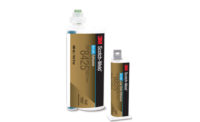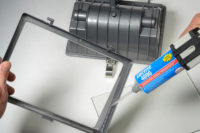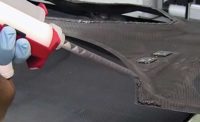Adhesives bond a wide array of automotive assemblies, including windshields, brakes, wire harnesses and exterior trim.
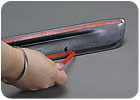
If, like I do, you own a vehicle with more than a 100,000 miles on it, then you know all too well why threaded fasteners are the predominant method of assembling automotive components: Threaded fasteners allow parts to be disassembled and replaced.
Look a little deeper, though, and you’ll find adhesives in a large number of applications in motor vehicles ranging from sports cars to heavy trucks. Beyond traditional applications, such as windshields, brake shoes and threadlockers, adhesives are now being used in applications that were once the exclusive domain of thermal and mechanical joining methods, including the frame, body, dashboard, engine and weather stripping.
What’s more, the number of automotive applications for adhesives is growing. According to Brian Cox, an engineer with the Industrial and Transportation Business of 3M Co. (Livonia, MI), there are several reasons for this trend. For one, today’s cars and trucks contain more plastic and composite parts than ever before, and mechanical fasteners are not always practical for attaching them. Adhesives also enable automakers to simplify their assembly processes. Parts that are bonded together don’t need holes to be drilled or punched, and assemblers don’t need to measure torque or double-check fastening operations. Eliminating fasteners also lowers vehicle weight, which is no small thing for automakers trying to maximize fuel economy. By one estimate, 70 pounds of adhesive can replace more than 200 pounds of mechanical fasteners.
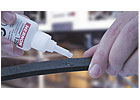
Cyanoacrylates cure rapidly to form rigid thermoplastics with excellent adhesion to most materials. Photo courtesy Hernon Manufacturing Inc.
Structural Adhesives
Methacrylates are among the most widely used adhesives in the automotive industry, according to Pat Shannon, North American sales and marketing manager for ITW Plexus (Danvers, MA). These two-component adhesives bond plastic, metal and composites, usually without the need for surface preparation. Mixed in a ratio of 1-to-1 or 10-to-1, methacrylates cure quickly at room temperature and can be dispensed from prepackaged cartridges or bulk containers.Methacrylates are good for assembling interior components because they are flexible enough to absorb impacts, but rigid enough to withstand high temperatures, says Shannon. Methacrylates assemble instrument panel components molded from polycarbonate and acrylonitrile-butadiene-styrene. Freightliner LLC (Portland, OR) uses methacrylates to bond thermoformed plastic parts for sleeper cabs, such as beds and cabinets.
Recently, methacrylates from ITW Plexus were certified by the Greenguard Environmental Institute (Marietta, GA) as being safe for use in vehicle interiors. The adhesives do not emit vapors that could adversely affect air quality inside a vehicle.
“Another good thing about using methacrylates for bonding plastics is that they don’t affect recyclability,” adds Shannon. “The adhesive is easily mixed into the reground material.”
Though interior assemblies are good applications for methacrylates, it’s in exterior and frame applications where these adhesives really come into their own. The adhesive is used to bond the composite hood of the Ford GT sports car, as well as the composite hoods and raised roofs on heavy trucks. Panoz Auto Development Co. (Hoschton, GA) uses methacrylate to bond the hood, deck, door liners and body panels on its AIV roadster. Leisure Travel Vans Ltd. (Morden, MB, Canada) uses methacrylate to bond fiberglass extension panels and roofs on conversion vans.
“Methacrylates bond very well to metal,” says Shannon. “A school bus manufacturer uses our adhesive to attach body panels on buses. With the adhesive, the manufacturer eliminated approximately 50 percent of the mechanical fasteners that it had been using to attach the panels. Plus, the adhesive distributes stress loads more evenly than rivets, so the bus actually performs much better in rollover and impact tests.”
A relative of methacrylates, cyanoacrylates, can also be found in automotive assemblies. Cyanoacrylates are solvent-free, one-component, room-temperature curing adhesives. When pressed into a thin film between two surfaces, cyanoacrylates cure rapidly to form rigid thermoplastics with excellent adhesion to most materials. TI Automotive (Warren, MI) uses a cyanoacrylate from Hernon Manufacturing Inc. (Sanford, FL) to bond steel clamps to rubber hoses. Bonding the clamp to the hose keeps it in place during shipping and makes the hose easy to assemble.
Acrylics are another structural adhesive that is widely used in automobiles. Available in both one- and two-component formulations, acrylics bond well to many substrates, including plastics, glass, ceramics and stainless steel. A two-component acrylic bonds magnets in stereo speakers.
Epoxies find their way into automobiles primarily through electrical and electronic assemblies. Epoxies pot or encapsulate printed circuit board assemblies, switches and sensors. These resins are also used in many ways in electric motors. To name a few applications, they bond lead wires to the stator, attach magnets to rotors, insulate the rotor and stator, and seal wire connectors.
“What’s great about epoxies is their flexibility,” says Harry Arnon, president of Hernon. “They are a whole family of materials. They can be rigid or flexible, one component or two component, heat curing or UV curing. Epoxies absorb vibration and shock, and they dissipate heat.”
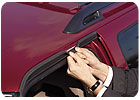
This weather strip is attached with an acrylic foam tape. Photo courtesy 3M
Tapes and Films
Adhesives for automotive assembly don’t have to be liquids. A variety of adhesive tapes and films are also used in vehicles.For example, a polyamid structural adhesive film from 3M is used to bond rearview mirrors to windshields. An unsupported, thermosetting, clear film, the adhesive provides high peel, shear and cleavage strength when bonding metal parts to metal, glass or ceramic. The adhesive is preapplied to the metal button that anchors the mirror to the glass. After the adhesive is firmly pressed into place on the glass, it will produce a tough, flexible bond in as little as 30 seconds at 450 F.
Bonding to glass is a challenging application for any sort of adhesive. “Glass is not the best surface in the world to bond to, because it’s extremely smooth, and you have a pretty small area to work with,” says Cox. “The film has some flexibility to resist shock and thermal stresses.”
Elsewhere in the interior, adhesive tapes bond headliners, upholstery and consoles. In air bag assemblies, foil tapes are used as burst shims in inflators, and low-fogging laminating adhesives are used for edge seals, anti-shrapnel mats and wrappers for curtain-wall systems. Smooth, clear laminating adhesives bond low-surface-energy plastics for backlit graphics in instrument panels.
Tapes are also used on vehicle exteriors. A structural bonding tape with an epoxy-modified acrylic adhesive is used to attach plastic or metal clips to painted or primed body panels. The adhesive is pre-applied to the clips, which are then pressed into place on the panels. Once attached, the adhesive is cured with heat to provide structural strength. Bonded clips eliminate the need to stamp holes or form upturned flanges in the sheet metal.
Nameplates, badges and emblems are attached with die-cut tape. The tape resists plucking and twisting forces associated with attaching these parts, especially those with narrow letters.
Weather strips are attached with an acrylic foam tape. “Many times, weather strips are mechanically fastened,” says Cox. “The tape improves noise, vibration and harshness performance, because it does not provide a path for sound to travel. It creates a sealed system.”
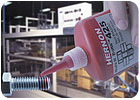
There can be as little as 15 percent metal-to-metal contact in a typical nut-and-bolt assembly. Threadlockers provide 100 percent contact between the two parts. Photo courtesy Hernon Manufacturing Inc.
Threadlockers and Retainers
Just as adhesives can augment welds and rivets, threadlockers represent another way that adhesives can complement mechanical fasteners in an assembly. Once tightened, a threaded fastener stays in place mostly through friction. Yet, there can be as little as 15 percent metal-to-metal contact in a typical nut-and-bolt assembly. Threadlockers provide 100 percent contact between the two parts. As the material cures, it completely fills the tiny gaps between the interfacing threads, locking the fasteners in place.Threadlockers are liquid, one-component anaerobic adhesives that cure when exposed to metal ions in the absence of air. They can be applied as a liquid at the time of assembly, or they can be preapplied to fasteners in the form of encapsulated beads in a dry film. When the fastener is installed, the beads break, releasing the adhesive.
Threadlockers are applied to bolts that must withstand elevated temperatures, extreme vibration and high levels of shear, tensile and rotational force. Thus, threadlockers are often used in engine, transmission, suspension, brake and motor assemblies. Because they seal threads as well as lock them, threadlockers are also desirable for applications involving fuel, oil, coolant and other fluids.
The latest development in threadlockers is surface-insensitive formulations. “In the past, anaerobic adhesives needed a highly active metal to cure,” explains Arnon. “If you wanted to use them on an inactive material, like stainless steel, you needed to treat the parts with an activator first. Surface-insensitive threadlockers overcome that obstacle. They are also more tolerant of surface contamination than the previous generation of threadlockers.”
Other anaerobics don’t lock the fastener, but act like Teflon tape in plumbing applications, preventing liquids from seeping past the threads. Fasteners for pneumatic, hydraulic and fuel assemblies are often treated with such sealants. Peterbilt Motors Co. (Denton, TX) uses such a material from Hernon to seal brass fittings on heavy trucks.
Another class of anaerobic adhesives-retaining compounds-is used to bond press-fit or slip-fit cylindrical assemblies, such as a bushing on a shaft or a freeze plug in an engine block.
A good example is the water crossover in an engine’s cooling system. A steel tube is pressed into a hole in an aluminum casting. “Because the coefficient of thermal expansion of aluminum is greater than that of steel, the aluminum part will pull away from the tube when the engine heats up,” explains Arnon. “A retaining compound seals the joint and holds the parts together.”
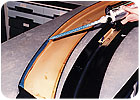
Methacrylate adhesive is applied to the rear deck spoiler of a sports car. Photo courtesy ITW Plexus
Liquid Gaskets
Liquid gaskets are adhesives that take the place of die-cut or molded solid gaskets made of cork, rubber and other materials. They have many automotive applications, including oil pans, oil seals, transmission pans, crankcases, axle covers, oil and air filters, fuel tanks and constant velocity joints.Although liquid gaskets are not considered structural adhesives, they do provide mild adhesion between the mating surfaces. This unitizes the assembly and limits relative motion between the parts.
There are two types of liquid gasket: cured in place and formed in place. Cured-in-place gaskets are cured with heat or UV light prior to assembly. This type of gasket is good for assemblies that require frequent service. Formed-in-place gaskets cure after the parts are assembled. One- and two-part liquid gaskets are available in anaerobic, silicone and urethane formulations.
Recently, Hernon supplied Federal Mogul Corp. (Southfield, MI) with a UV-curing gasketing material for an oil seal application. An oil seal encircles a rotating shaft to prevent lubricants or fluids from leaking out. “The company had been using a solvent-based rubber material,” recalls Arnon. “There were two problems with that material. First, you had to wait hours for the gasket to cure. And second, emissions from the evaporating solvent were terrible. We provided a 100-percent solids material that cures instantly when exposed to UV light. Now, it’s a continuous process instead of a batch process.”

